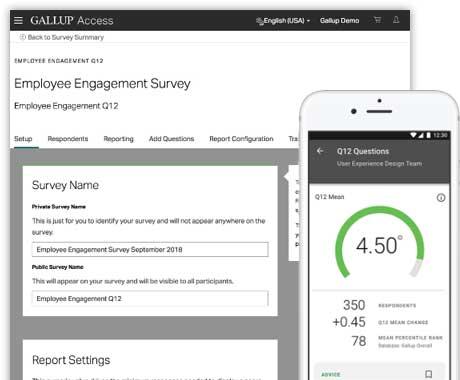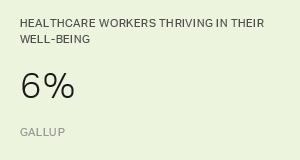Story Highlights
- Amid disruption, Highmark Health activated as a team to do what was right
- A devotion to delivering excellence to customers was key to approach
- Learn how to embrace disruption, step up change and build for the future
The only constant is change, and today's companies are grappling with change on a massive scale. Even during less eventful times, companies invest significant resources to manage their change initiatives with no guarantee of success.
When change processes do stick, they can succeed beyond leaders' expectations, going deep enough to transform the organization's very DNA. Some companies see that as a grim surprise. Some see it as a cultural triumph.
Highmark Health is among the latter. One of the largest integrated delivery and financing systems in the U.S., Highmark Health serves 40 million customers across Pennsylvania, Delaware, and West Virginia from its Pittsburgh home office, and is affiliated with the Allegheny Health Network's (AHN) nine hospitals and more than 200 primary- and specialty-care practices.
The pandemic forced change on Highmark Health, just as it has on every organization in healthcare. But unlike some, Highmark Health's DNA is pre-set for change -- in fact, its mission is to "revolutionize healthcare."
"We're turnaround experts," says Highmark Health's Chief Operating Officer, Karen Hanlon. "When we know who the opponent is, and when we know what we're up against, we activate like a team to do what is right."
When changes processes do stick, they can succeed beyond leaders' expectations, going deep enough to transform the organization's very DNA.
Highmark Health's first significant change-management challenge came in 2015. At the time, Highmark Health had already had two CEO changes in three years, had lost $600 million in 2015 Affordable Care Act (ACA) insurance plans, was involved in a Department of Justice suit, and was actively integrating AHN -- which was itself losing $135 million a year -- into the organization.
Then David Holmberg took over as CEO. Under his leadership, the company took the suit all the way to the Supreme Court, "and got our customers' money back," says Hanlon, turned AHN's financials around, and found ways to keep its ACA promises. As of 2019, Highmark Health revenue was up to $18 billion.
In other words, Highmark Health is built for change -- and four essential qualities allow it to be.
Highmark Health makes defined behaviors part of the operating system.
When Holmberg took the reins, he found that Highmark Health was a collection of many different subcultures, each was passionately -- but singularly -- devoted to delivering excellence to its customers.
Holmberg saw that as evidence of genuine customer centricity that could be undermined by a too-heavy leadership hand. Still, Highmark Health's 43,000 employees needed to adapt to constant change and live the brand as one, even if their strategies were unique to the group. So the leadership team, with input from various levels, functions, and business lines, conceptualized "the Core Behaviors" -- Customer First, Purposeful Execution, Transformational Leadership and Trust Working Together -- as an operating system that guides and inspires employees' approach to just about everything.
"They're part of our fundamental terminology…a part of our fabric," Hanlon says. "They are how we expect ourselves to act, irrespective of the strategy that we're running."
The Core Behaviors are real and practical ways of managing, leading, and individually performing, and became quickly enculturated through in-person, print, and online communication, even name tags. CHRO Larry Kleinman's team and Gallup created toolkits for leaders and managers to help make the behaviors a lived aspect of performance management, including books on various topics -- the third edition centers on tech and future-of-work ideas. Census and pulse surveys indicate how the Core Behaviors are experienced and their impact on customers and patients.
Highmark Health integrates employee engagement into strategy.
Employee engagement indicates the degree to which change is accepted -- or better, championed -- so Highmark Health uses Gallup's Q12 to measure employee engagement, and has instituted engagement councils at multiple levels. Highmark Health's objective for these councils, indeed for engagement itself, is "freeing people to be their best." This means removing barriers, changing processes, empowering employees, and focusing on customer outcomes at the business unit and individual contributor level.
"Different people bring different perspectives," says Sarah Marche, who leads Highmark Health's Pharmacy Services and runs the engagement council for the Health Plan. "These councils help us think through how we should roll out initiatives based on their view of what that employee population needs." And the councils have teeth: Each has the authority to make decisions and act on them at the business unit level to quickly move ideas into implementation.
The strategy is paying off. Engagement numbers are rising consistently and, with them, productivity. Claims employees who are engaged handle 45% more transactions than the disengaged, Call Center employees who are engaged handle 11% more, and engaged nursing units drive significantly higher HCAHPS scores and patient recommendations. No wonder -- Gallup analysis shows engaged employees are four times more likely to be high performers at Highmark Health -- but if Highmark Health can raise the entire employee population to the top quartile of Gallup's database, Highmark Health will yield nearly $16 million in savings.
To get there, Highmark Health is prioritizing individual development, recognition through highly targeted awards and daily Core Behavior reinforcement during huddles. Highmark Health is also triangulating its engagement strategy with customer and patient outcomes -- a brilliant move for such a customer-centric organization -- particularly where the customer needs the most support.
Claims employees who are engaged handle 45% more transactions than the disengaged, Call Center employees who are engaged handle 11% more, and engaged nursing units drive significantly higher HCAHPS scores and patient recommendations.
Consider, for example, Highmark Health's new Women and Infants Center at AHN's Jefferson Hospital in Jefferson Hills, Pennsylvania. Joy Peters, the hospital's Chief Nursing Officer, says that a community needs assessment showed that 3,500 women had traveled an hour to a different hospital to give birth. In the new hospital, 700 women became patients (her team expected 500) the first year alone. But inventing a whole new hospital is no small trick, and Peters says engagement was crucial to enlisting employees in the project. "We freed people to be their best by taking away extra steps that wasted time so they could focus on caring for the patients," she says. "When you have people who can help you create these types of programs, who help you see it come alive successfully, that is huge."
That's an important point and can go unnoticed in discussions of change management. Engagement builds trust and creates a more open culture. Employees who don't understand why changes are happening can become resistant to and reject accountability for change, which is one reason why change initiatives fail.
However, Hanlon believes that, despite its current success, Highmark Health's engagement strategy will need to evolve -- massive disruption will demand greater tenacity of Highmark Health employees, she says, and a remote work environment requires more communication. "Engagement is going to be even more important in the years to come," she says, "so we can continue to deliver on some pretty lofty goals and pretty stretched transformational initiatives. We're not going to have the luxury of sitting around the conference table together and being able to collaborate in-person."
Highmark Health's innovation culture is technology-enabled but people-driven.
The rewards of being first and better are why so many organizations strive for an "innovation culture" that inspires employees to reach further, create new opportunities or place bets on trends that can disrupt the marketplace. Highmark Health subscribes to that attitude, but it's not chasing S-curves -- innovation outcomes have to provide real business value, typically enumerated by Net Present Value over five years and leveraging other leading innovation value indicators.
Engagement builds trust and creates a more open culture. Employees who don't understand why changes are happening can become resistant to and reject accountability for change, which is one reason why change initiatives fail.
Yet employees have the latitude to take risks (or even fail) as long as the innovation outcomes are apparent, and the quality of healthcare improves by it.
That requires some sort of structure, but Highmark Health went all the way to creating its own skunkworks, called thinkUP. Though it began as an internal tech consulting unit, the group's remit has expanded to examining the value potential of specific technology, soliciting first-person input, and expanding the impact of Highmark's talent with innovative D&I strategies, highly specific upskilling, and internal mobility initiatives. Re-imagining work is fundamental to that -- and improved processes are often the result -- and it makes thinkUP an innovation accelerator. Those involved in thinkUP are close to twice as likely to feel encouraged to come up with new and better ways of doing things. And Gallup research for Highmark Health found that a highly engaged employee population generates 26 times more innovative ideas than disengaged ones.
"Engagement is going to be even more important in the years to come… We're not going to have the luxury of sitting around the conference table together and being able to collaborate in-person." -- Karen Hanlon, Highmark Health's Chief Operating Officer
According to Kleinman, part of the rationale behind thinkUP was centralizing innovation investments so that Highmark Health could focus on tools that drive value, not get bogged down proving their worth. So, you'd expect a high-level initiative like thinkUP to be spearheaded by a chief digital officer, or a chief technology director, even a financial officer. But Kleinman himself is the thinkUP lead -- Highmark Health believes transformative digital and tech innovation should move in lockstep with people strategy. And the premise has proven correct: In its first year, the thinkUP team implemented 15 projects that returned $60 million NPV in value to the company.
Meanwhile, even as thinkUP seeks ways to improve the organizational process, Highmark Health keeps raising the stakes by pursuing revolutionary projects like Robotic Process Automation, Machine Learning and Chatbots. And it's creating a "blended health" approach through its VITAL Innovation Platform, which amalgamates the company's diversified businesses, people assets and technology to test and validate early-stage, FDA-approved medical innovations.
Highmark Health leverages a vast internal and external talent ecosystem.
The systemic transformation Holmberg and his team introduced means talent attraction and development has to fit into Highmark Health's unique cultural context. For that reason, Highmark Health leveraged Gallup's talent-based hiring instrument. Now, new hires have industry-leading expertise as well as raw talent, and the Core Behaviors create a framework that achieves cultural fit as well. And managers hired from this selection process are almost two times more likely to receive outstanding or extraordinary manager ratings.
But there won't ever be enough talent on offer to fill the needs of Highmark Health's ever-changing innovation landscape. So, in a characteristically open-minded move, Highmark Health chose to maximize their innovation spend by inviting outside experts to consult with the thinkUP team in a three-tiered partner ecosystem that includes consulting firms and technology experts. With their specific skills and expertise, these external consultants can offer the end-to-end capability Highmark Health needs to innovate successfully, and quickly.
"We're only going to do projects where we can quantify value," Kleinman says. "They (the experts) have to be fast. Get in. Get out, get the value and move to the next project."
In its first year, the thinkUP team implemented 15 projects that returned $60 million NPV in value to the company.
That ecosystem has come to include a crowdsourcing platform that uses a machine-learning algorithm to match high expertise, talented independent consultants to critical projects. This VC-like focus drives a seamless integration of external expertise and internal implementation and has paid off on multiple mission-critical initiatives. And Highmark Health gets the benefit of partnering their leaders and managers with industry and technology experts working on several high stakes projects.
Aiming for a Higher Mark
Highmark Health is doing change right.
From setting up engagement councils to re-imagining work to integrating technology with people and talent assets, it has made the most of change. But Highmark Health knows its transformative journey has no end -- and the company is banking on the collective genius of all its employees to keep driving performance, embracing disruption and making healthcare better.
"We're really in full transformation mode," Hanlon says, "and we are now thinking, we've got all the assets to do healthcare differently, but what do we want our future to look like? How do we want it to work? What can we do to drive to that vision?"
One by one, Highmark Health's changes since 2015 seem momentous. Taken together, they seem like an almost incomprehensibly big change -- but that's what it takes to create "a world where everyone embraces health," as the Highmark Health System vision statement puts it. And anyway, Highmark Health is built for change. In the scheme of things, whatever their next challenge is will just be the logical next step of revolutionizing healthcare.
Learn more about Gallup's solutions for transforming healthcare:
- Discover how to improve outcomes across critical domains of clinical and financial performance.
- Watch our webinar "6 Key Elements of Healthcare Transformation" to hear one health system's journey to improved outcomes.
- Navigate the evolving COVID-19 disruption with the latest Gallup insights.







